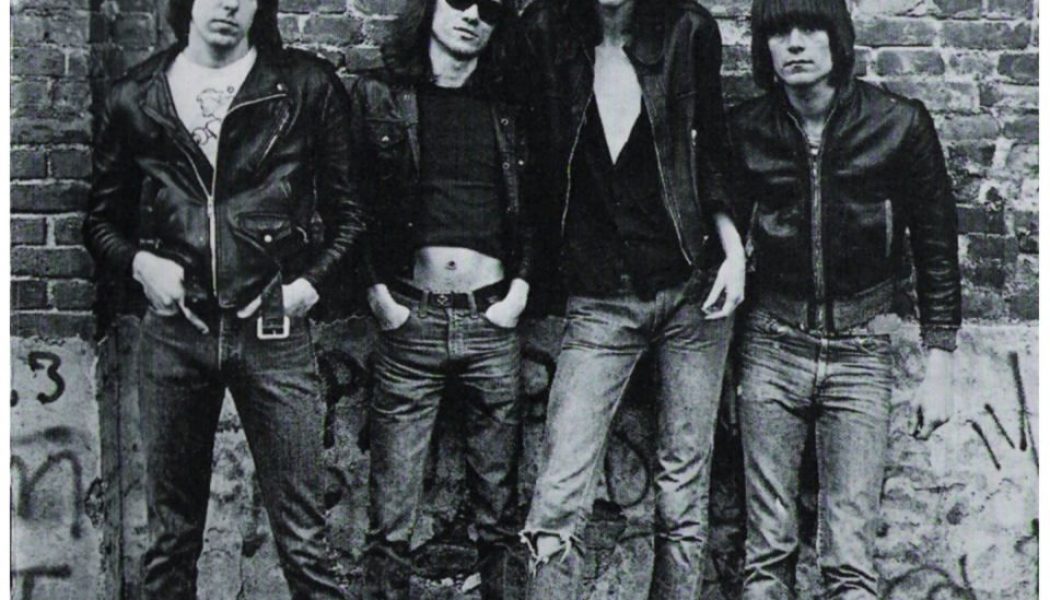Editor’s Note: On April 23, 1976, four twentysomethings from Queens with shades, blue jeans, and leather jackets released their self-titled debut and started the punk rock movement. Our own Lindsay Teske takes a look back on those days as the Ramones’ first record turns 45.
The 1970s were destined to undergo a cultural shift. The many effects of the Vietnam War had long been taking their toll, the bizarre circus of the Nixon and Ford presidencies had fatigued many and generated a deep sense of distrust in the government, and the cherry on top of it all was an ongoing recession that absolved the idea of stable employment for countless. In contrast to the commotion happening on the world’s stage, swathes of saccharine pop culture were having quite the day in the sun. The turn of the decade saw ‘60s rock figureheads Paul McCartney and Eric Clapton try their hand at easy listening, the simultaneous rise of The Brady Bunch and The Partridge Family made television shows about smiley, singing families a mainstay, and the Bay City Rollers were filling the airwaves with syrupy love songs as they swayed along in their culottes.
An uptick in candy-coated culture made sense at the time. As we’re all aware from the past year we’ve had, when the world feels too weighty, there are times where nothing seems more appealing than seeking out an entertainment equivalent of a frosted cupcake just to escape from it all for a bit. It’s no wonder that, back then, the Brady children and their plucky message of “keep on, keep on, keep on moving” did so well.
Related Video
Just a few months after The Brady Bunch drew to a close and The Partridge Family soon followed weeks later, encouraging the nation to “come on, get happy” one last time, four young men from Forest Hills, New York, would step onstage for the first time and declare that “all the kids wanna sniff some glue.”
The Ramones had arrived.
For as many people who needed the entertainment equivalent of a frosted cupcake to handle the times, there were those who needed the entertainment equivalent of a shot of whisky. That’s the antidote the Ramones audaciously ushered in upon the release of their 1976 self-titled debut album, lighting the fuse of what would become the first wave of punk in the process.
The “who was the first punk band” debate has thrown names like The Hollywood Brats and The Saints into the ring, and while both bands toted certain bits and pieces of punk (The Hollywood Brats were a glam rock band, though they had a punk-adjacent attitude, and The Saints delivered thrashy chord progressions), it was the Ramones who made the genre what it is by giving it its most defining element: anger. In the middle of an exhausting decade that had been preceded by yet another exhausting decade, the Ramones made music that served as a much-needed catharsis for the bitterness and bite many folks at the time were understandably harboring.
The Ramones’ ability to create such a catharsis stemmed from the mastery of universalism they demonstrated on Ramones and throughout their subsequent discography. Much of the beauty of tracks like “Beat on the Brat”, “Loudmouth”, and “I Don’t Wanna Walk Around with You” were rooted in the fact that anyone could listen to them and apply the lyrics to their own life. Whether you were a recent graduate feeling the strain of entering a workforce that left much to be desired, exhausted from the weight of the ongoing war, pissed off about politics, or simply had your day ruined by the driver who cut you off on your morning commute, Ramones was an album you could turn to to let it all out. The roles of the brat, the loudmouth, and whoever it was you wanted to get the hell away from could be filled by anyone and anything you wished. This gave the Ramones an inherent sense of relatability and connectivity that would go on to fuel both their growth and their legacy.
Another reason Ramones was such a cultural catalyst is because it incorporated elements into heavy music that hadn’t found a home in it prior, such as, for example, the doo-wop vocal stylings heard on “Chain Saw”. Ingredients that had mainly been used to stitch together pop songs — insatiably catchy melodies, hooks you couldn’t forget if you tried, and lyrics that created an impulse to shout along to — were now being applied to pint-sized power blasts of songs that were garnished with scratchy power chords and prominent bass lines. Particularly at a time where rock tracks were taking on an increasingly grandeur style (Led Zeppelin’s “Kashmir” was released just a year prior to Ramones), the stylistic approach they delivered felt revolutionary, and it showed that a song didn’t need to be nearly 10 minutes to pack a punch — in fact, the longest track on Ramones, “I Don’t Wanna Go Down to the Basement”, barely skirts the three-minute mark.
Ramones also wove candid lyrics about love and heartbreak into this soundscape, and what makes this feel so profound is that the tone of the music never shifted to match the more sullen tone of the lyrics. For example, “Listen to My Heart” clatters on with the typical Ramones gusto despite Joey Ramone’s lamenting of being “Tired of the pain/ Tired of crying.” Unlike much of the music with similar subject matter at the time, Ramones demonstrated that you didn’t have to wallow in your negative emotions — you could be fueled by them. When it’s taken into account that folks around the world had likely wept to the Bay City Rollers’ cover of “Bye Bye Baby” just 13 months prior, the approach the Ramones took to presenting this nature of emotion felt fresh. Ultimately, this became one of the defining elements of punk as a genre. It wasn’t about being tough, cool, macho, or keeping your thoughts and feelings bottled up. Rather, it was about boldly laying it all on the table (whatever “it” was to you) and expressing it with bite, velocity, and grit.
There was also a kind of power that came from the sentiments of the album being expressed by a band who seemed like a group of guys you’d bump into while on a beer run at your local corner shop. While much of the rock music of the early ‘70s was so enveloped in the dazzle of showmanship that it felt almost out of reach, the Ramones rebranded the idea of the rock star as an everyman. In a stark contrast from the glitter and shimmer of glam rock specifically, the Ramones — perpetually donning jeans, sneakers, and leather jackets — marked one of the first times a rock band looked like you, your friends, or people in your community. It made the band, their spirit, and punk as a new genre strike a stronger chord of resonance. Both the band and the new kind of music they created felt approachable — so much so that people felt inspired to try their hand at creating punk music themselves, and as we know, they did.
Ramones, with their everyman essence and open-ended lyrics, meant that anyone could and did find resonance in punk. This is largely what fanned the flames of punk as a genre upon the album’s release. While the first wave was largely mobilized by working-class youth, the world soon learned that it was not just a genre for the young and jaded. Punk fans could be, and were, anyone. And though it was not just a genre for the young and jaded, it did give them a feeling of representation and cultural identity, and that was significant. Generations that were having to reckon with coming of age and entering the job market under precarious circumstances were able to listen to music by a band who was close to their own age, dressed like people they knew, and were unapologetically loud, bold, and present. This gave them a sense of empowerment to harness these qualities themselves. However, this was seen as a threat.
Rock ‘n’ Roll High School, a film that chronicled P.J. Soles’ Riff Randell on her quest to deliver lyrics she’d written to the Ramones while keeping her school administrators none the wiser, finds its antagonist in the character of Principal Togar. Togar displays a moral resistance to punk and youth culture throughout the film that culminates in her setting a large pile of Ramones records ablaze (shortly before hilariously asking the Ramones themselves, who appeared throughout the film, if “their parents knew they’re Ramones”). Despite being a fictional character, Togar represented a very real sector of the global population that viewed punk as a direct challenge to societal order. Those who would have been of the age to become parents and professionals by the late ‘70s belonged to the Silent Generation, where the “children should be seen and not heard” mentality prevailed heavily. Therefore, younger folks having their voices and views emboldened by a brazen, new offshoot of rock completely countered their perceptions of what respectable behavior looked like.
Due to a combination of the Ramones’ everyman nature and uncontroversial lyrics, they were more of a threat to punk’s growth. Whereas it would be easy for, say, a rigid parent to look at a band who had ruffled more feathers and think that their child would never indulge in anything like that, the same couldn’t be said for the Ramones. After all, one would have to be hard-pressed to find an issue with guys in skinny jeans singing about listening to their heart and wanting to be someone’s boyfriend. Punk created discomfort, but the Ramones didn’t give anyone much of a reason to take issue with it right off the bat. Because of this, punk was able to spread into the ears of those who may not have gravitated toward or been exposed to heavy music prior. This is largely how punk evolved from a style of music bought onto the scene from a single record into a movement that would span decades.
1976 is regarded as “year zero” in punk history, a ferocious foreword chapter to what would become an epic tale. Ramones was the record that put the wheels of year zero in motion. Months after its April debut, The Damned made history by releasing “New Rose”, the first British punk single. The year also saw the formation of The Clash, and by December, the Sex Pistols had sparked nationwide outrage after television host Bill Grundy baited them into swearing on air. This, coupled with the fact that they dared to express anything other than a favorable view of the monarchy, led to their winter ‘76 “Anarchy Tour,” which also featured The Clash and The Damned, having an infamous number of cancellations (when it came to moral panic around punk, the British media made Principal Togar look like a picture of calm).
While these bands were obviously active prior to the events in 1976 that put them on the world’s stage, the punk movement across the pond was undoubtedly mobilized by the fact that the first punk record, Ramones, had come into existence earlier that year. The record catapulted the genre’s signature sounds into cultural consciousness and demonstrated that it was a style and ethos in which fans and intermediaries alike were willing to get behind, which paved the way for punk artists for years to come. For example, it’s hard to imagine a world where the doo-wop stylings of the Misfits’ “Saturday Night” or the rapid, fuzz-fueled blast of Black Flag’s “Nervous Breakdown” exist without the legacy of Ramones.
Perhaps the greatest legacy of Ramones was that it shook up the idea of who a “rock star” could be. No more was it a term that largely invoked imagery of a group of long-haired, young Englishmen who made six-minute songs filled with thinly veiled metaphors about sex. The Ramones made it feel like it could be you. It made you feel like you could bash out a riff and scrawl down lyrics to create a song about something you either loved or hated so much that you needed to express it in the biggest and brashest manner of all. Whether that be fondness for a new partner, frustration about automatically being born as a “subject,” the police, mental health, politics, the economy, or even something you made up about zombies and demons, punk was something you and people like you could create to have your voice be heard.
Especially in a time where so much of music was enveloped in the idea of putting on a superfluous show for the audience, punk made the audience feel like they could be a part of the show themselves. The punk movement saw dozens of truly incredible and game-changing bands form — not to mention the scores of DIY punk bands of today and yesterday whose names we may not even know — and whether directly or indirectly, they all got their seat at the table because four young men from Forest Hills, New York, pulled up a chair for them in April of 1976.
—
Pick up a copy of Ramones here…
Ramones Artwork
<img data-attachment-id="501202" data-permalink="https://consequence.net/2014/06/the-ramones-debut-album-goes-gold-nearly-40-years-later/ramones-1976/" data-orig-file="https://consequence.net/wp-content/uploads/2014/06/ramones-1976.jpg?quality=80" data-orig-size="960,960" data-comments-opened="1" data-image-meta="{"aperture":"0","credit":"","camera":"","caption":"","created_timestamp":"0","copyright":"","focal_length":"0","iso":"0","shutter_speed":"0","title":""}" data-image-title="ramones 1976" data-image-description="
ramones 1976
” data-medium-file=”https://consequence.net/wp-content/uploads/2014/06/ramones-1976.jpg?quality=80&w=300″ data-large-file=”https://consequence.net/wp-content/uploads/2014/06/ramones-1976.jpg?quality=80&w=960″ loading=”lazy” class=”aligncenter size-full wp-image-501202 jetpack-lazy-image” src=”https://consequence.net/wp-content/uploads/2014/06/ramones-1976.jpg?quality=80&resize=1031%2C580&strip&is-pending-load=1″ alt=”ramones 1976″ width=”100%” data-lazy-srcset=”https://consequence.net/wp-content/uploads/2014/06/ramones-1976.jpg 960w, https://consequence.net/wp-content/uploads/2014/06/ramones-1976.jpg?resize=150,150 150w, https://consequence.net/wp-content/uploads/2014/06/ramones-1976.jpg?resize=300,300 300w, https://consequence.net/wp-content/uploads/2014/06/ramones-1976.jpg?resize=768,768 768w, https://consequence.net/wp-content/uploads/2014/06/ramones-1976.jpg?resize=350,350 350w, https://consequence.net/wp-content/uploads/2014/06/ramones-1976.jpg?resize=79,79 79w, https://consequence.net/wp-content/uploads/2014/06/ramones-1976.jpg?resize=640,640 640w, https://consequence.net/wp-content/uploads/2014/06/ramones-1976.jpg?resize=96,96 96w, https://consequence.net/wp-content/uploads/2014/06/ramones-1976.jpg?resize=912,912 912w, https://consequence.net/wp-content/uploads/2014/06/ramones-1976.jpg?resize=550,550 550w, https://consequence.net/wp-content/uploads/2014/06/ramones-1976.jpg?resize=470,470 470w” data-lazy-sizes=”(max-width: 960px) 100vw, 960px” srcset=”data:image/gif;base64,R0lGODlhAQABAIAAAAAAAP///yH5BAEAAAAALAAAAAABAAEAAAIBRAA7″>
<img data-attachment-id="501202" data-permalink="https://consequence.net/2014/06/the-ramones-debut-album-goes-gold-nearly-40-years-later/ramones-1976/" data-orig-file="https://consequence.net/wp-content/uploads/2014/06/ramones-1976.jpg?quality=80" data-orig-size="960,960" data-comments-opened="1" data-image-meta="{"aperture":"0","credit":"","camera":"","caption":"","created_timestamp":"0","copyright":"","focal_length":"0","iso":"0","shutter_speed":"0","title":""}" data-image-title="ramones 1976" data-image-description="
ramones 1976
” data-medium-file=”https://consequence.net/wp-content/uploads/2014/06/ramones-1976.jpg?quality=80&w=300″ data-large-file=”https://consequence.net/wp-content/uploads/2014/06/ramones-1976.jpg?quality=80&w=960″ loading=”lazy” class=”aligncenter size-full wp-image-501202″ src=”https://consequence.net/wp-content/uploads/2014/06/ramones-1976.jpg?quality=80&resize=1031%2C580&strip” alt=”ramones 1976″ width=”100%” srcset=”https://consequence.net/wp-content/uploads/2014/06/ramones-1976.jpg 960w, https://consequence.net/wp-content/uploads/2014/06/ramones-1976.jpg?resize=150,150 150w, https://consequence.net/wp-content/uploads/2014/06/ramones-1976.jpg?resize=300,300 300w, https://consequence.net/wp-content/uploads/2014/06/ramones-1976.jpg?resize=768,768 768w, https://consequence.net/wp-content/uploads/2014/06/ramones-1976.jpg?resize=350,350 350w, https://consequence.net/wp-content/uploads/2014/06/ramones-1976.jpg?resize=79,79 79w, https://consequence.net/wp-content/uploads/2014/06/ramones-1976.jpg?resize=640,640 640w, https://consequence.net/wp-content/uploads/2014/06/ramones-1976.jpg?resize=96,96 96w, https://consequence.net/wp-content/uploads/2014/06/ramones-1976.jpg?resize=912,912 912w, https://consequence.net/wp-content/uploads/2014/06/ramones-1976.jpg?resize=550,550 550w, https://consequence.net/wp-content/uploads/2014/06/ramones-1976.jpg?resize=470,470 470w” sizes=”(max-width: 960px) 100vw, 960px”>









